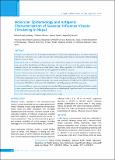Please use this identifier to cite or link to this item:
https://hdl.handle.net/20.500.14356/1621Full metadata record
| DC Field | Value | Language |
|---|---|---|
| dc.contributor.author | Upadhyay, Bishnu Prasad | - |
| dc.contributor.author | Ghimire, Prakash | - |
| dc.contributor.author | Tashiro, Masato | - |
| dc.contributor.author | Banjara, Megha Raj | - |
| dc.date.accessioned | 2023-05-16T10:21:36Z | - |
| dc.date.available | 2023-05-16T10:21:36Z | - |
| dc.date.issued | 2017 | - |
| dc.identifier.citation | UpadhyayB. P., GhimireP., TashiroM., & BanjaraM. R. (2017). Molecular Epidemiology and Antigenic Characterization of Seasonal Influenza Viruses Circulating in Nepal. Journal of Nepal Health Research Council, 15(1). https://doi.org/10.33314/jnhrc.v15i1.970 | en_US |
| dc.identifier.issn | Print ISSN: 1727-5482; Online ISSN: 1999-6217 | - |
| dc.identifier.uri | http://103.69.126.140:8080/handle/20.500.14356/1621 | - |
| dc.description | Original Article | en_US |
| dc.description.abstract | Abstract Background: Influenza is one of the public health burdens in Nepal and its epidemiology is not clearly understood. The objective of this study was to explore the molecular epidemiology and the antigenic characteristics of the circulating influenza viruses in Nepal. Methods: A total of 1495 throat swab specimens were collected from January to December, 2014. Real time PCR assay was used for identification of influenza virus types and subtypes. Ten percent of the positive specimens were randomly selected and inoculated onto Madin-Darby Canine Kidney Epithelial cells (MDCK) for influenza virus isolation. All viruses were characterized by the hemagglutination inhibition (HI) assay. Results: Influenza viruses were detected in 421/1495 (28.2%) specimens. Among positive cases, influenza A virus was detected in 301/421 (71.5%); of which 120 (39.9%) were influenza A/H1N1 pdm09 and 181 (60.1%) were influenza A/H3 subtype. Influenza B viruses were detected in 119/421 (28.3%) specimens. Influenza A/H1N1 pdm09, A/H3 and B viruses isolated in Nepal were antigenically similar to the vaccine strain influenza A/California/07/2009(H1N1pdm09), A/Texas/50/2012(H3N2), A/New York/39/2012(H3N2) and B/Massachusetts/2/2012, respectively. Conclusions: Influenza viruses were reported year-round in different geographical regions of Nepal which was similar to other tropical countries. The circulating influenza virus type and subtypes of Nepal were similar to vaccine candidate virus which could be prevented by currently used influenza vaccine. Keywords: Characterization; epidemiology; influenza virus; Nepal. | en_US |
| dc.language.iso | en | en_US |
| dc.publisher | Nepal Health Research Council | en_US |
| dc.relation.ispartofseries | Jan-April, 2017;970 | - |
| dc.subject | Characterization | en_US |
| dc.subject | Epidemiology | en_US |
| dc.subject | Influenza virus | en_US |
| dc.subject | Nepal | en_US |
| dc.title | Molecular Epidemiology and Antigenic Characterization of Seasonal Influenza Viruses Circulating in Nepal | en_US |
| dc.type | Journal Article | en_US |
| local.journal.category | Original Article | - |
| Appears in Collections: | Vol. 15 No. 1 Issue 35 Jan-Apr 2017 | |
Files in This Item:
| File | Description | Size | Format | |
|---|---|---|---|---|
| 970-Manuscript-1879-1-10-20170608.pdf | Fulltext Download | 1.14 MB | Adobe PDF |  View/Open |
Items in DSpace are protected by copyright, with all rights reserved, unless otherwise indicated.
